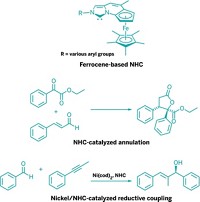Advertisement
Grab your lab coat. Let's get started
Welcome!
Welcome!
Create an account below to get 6 C&EN articles per month, receive newsletters and more - all free.
It seems this is your first time logging in online. Please enter the following information to continue.
As an ACS member you automatically get access to this site. All we need is few more details to create your reading experience.
Not you? Sign in with a different account.
Not you? Sign in with a different account.
ERROR 1
ERROR 1
ERROR 2
ERROR 2
ERROR 2
ERROR 2
ERROR 2
Password and Confirm password must match.
If you have an ACS member number, please enter it here so we can link this account to your membership. (optional)
ERROR 2
ACS values your privacy. By submitting your information, you are gaining access to C&EN and subscribing to our weekly newsletter. We use the information you provide to make your reading experience better, and we will never sell your data to third party members.
Synthesis
Nitrogen-phosphorus heterocycles abound
Two research groups prepare the first examples of azadiphospholides and azatriphospholenes
by Stephen K. Ritter
July 31, 2017
| A version of this story appeared in
Volume 95, Issue 31
Chemists over the years have explored countless ways to incorporate boron, nitrogen, oxygen, phosphorus, sulfur, and other elements into carbon ring systems. Creating these so-called heterocyclic compounds is like adding new flavors to a menu for chemists to try out, for example, when making optoelectronic materials, creating new catalysts, or developing new drugs. Continuing the trend, two research groups are reporting the addition of new types of nitrogen-phosphorus heterocycles. In one example, Hansjörg Grützmacher of ETH Zurich, Zoltán Benkő of Budapest University of Technology & Economics, and coworkers have prepared annulated 1-aza-3,4-diphospholides by adding sodium phosphaethynolate to 2-chloropyridines (Angew. Chem. Int. Ed. 2017, DOI: 10.1002/anie.201705473). Cyano-substituted versions of the azaphospholides are deeply colored and have widely tunable optical properties, which could make them useful as ion sensors or as precursors for fabricating light-emitting diodes. In the other example, Ian Manners and coworkers of the University of Bristol have prepared 1-aza-2,3,4-triphospholenes by catalytically clicking together cyclophosphines and various nitriles (Angew. Chem. Int. Ed. 2017, DOI: 10.1002/anie.201704991). The researchers found the chemistry can be used to functionalize cyano groups on polymers, and the electron-rich free heterocycles exhibit strong coordination properties, which could make them useful as ligands for heterobimetallic catalysts.





Join the conversation
Contact the reporter
Submit a Letter to the Editor for publication
Engage with us on Twitter